British Columbia Is One of the Best Places to Backcountry Ski — Here Are the Top Mountains and Resorts
Interest in backcountry skiing has never been higher. If you're looking to go off-piste, head to British Columbia, home to North America's most rugged terrain.
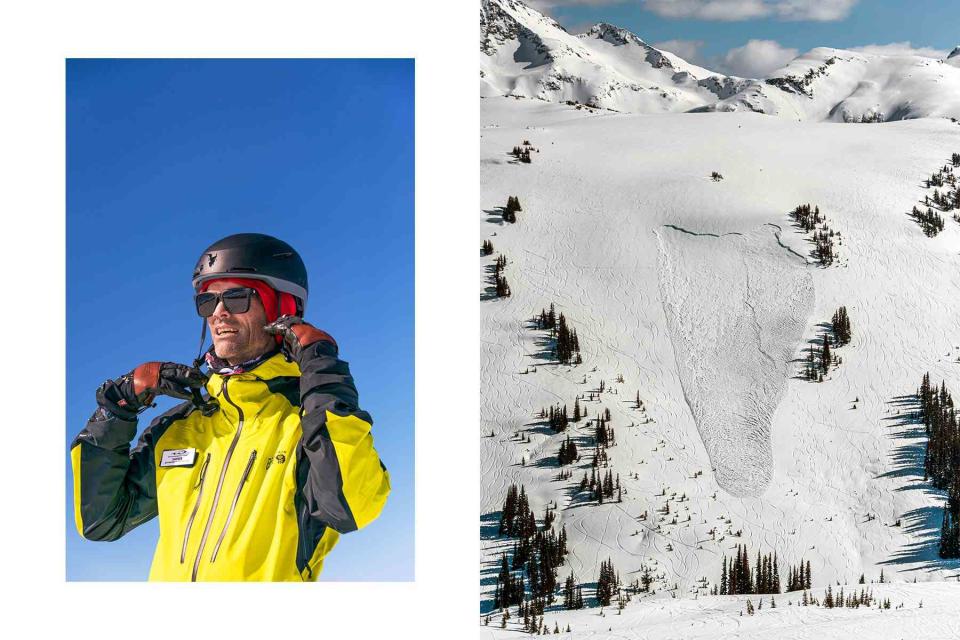
Kari Medig
Selda fastens his helmet before a run.It was a sunny morning on the slopes of Whistler, in British Columbia, and I was skiing down a run called Burnt Stew. The snow under my feet hissed and chattered while the wind weaseled under my jacket cuffs, down my neck, and around the vents in my goggles. Focus, I told myself. You need speed.
The slope hairpinned hard to the left. The few lucky skiers up on the mountain on a midwinter Tuesday followed gravity down toward town and its parade of world-class hotels, sushi joints, and rowdy bars. My guide, Jamie Selda, didn’t make the turn. Instead, he shot right past the curve and straight off the slope into a quieter, wilder world of blue and white.
Related:
I followed him, shooting horizontally across the mountain instead of down it. The momentum drained from my skis, and I looked up and gasped.
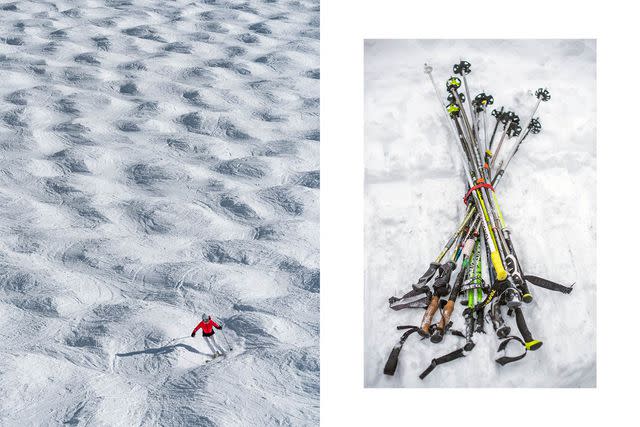
Kari Medig
From left: Navigating the bumps below the Glacier Express lift, on Blackcomb Mountain; ski poles outside Big Red Cats, a tour operator in Rossland.For decades, skiing has ruled my winters and framed my travels. Road trips. Train trips. Where I went to college and where I lived. It’s taken me to 15 countries on four continents, to wish-list destinations like Switzerland and Japan, but also to hauntingly gorgeous ones few people talk about — Afghanistan, Kosovo, even North Korea. But standing there, less than two hours from the dim sum spots of downtown Vancouver, I was speechless.
Tremendous mountains of ice and rock rose around me. It would take a lifetime to ski a fifth of what I could see, but it was what I didn’t see that made me giddy: a chairlift. From that point on, what skied down must first ski up, and that, as Selda showed me, is an art in its own right.
Now, with ski areas getting more crowded, and our hunger for fresh powder all the more ravenous, backcountry skiing is once again having a moment. When the pandemic forced ski areas to prune their seasons and limit capacity, getting off-trail suddenly had even greater appeal.
Long before the invention of “six-pack” lifts with heated seats and pistes groomed to perfection, backcountry skiing was the only skiing, of course. When Stone Age snow hunters stalked ibex in the Altai, they just strapped on their hand-hewn tree trunks and went for it. Before Sun Valley, Idaho, got the world’s first chairlift, in 1936, our baggy-wool-wearing forebears had to hike up Dollar Mountain to earn their turns. Now, with ski areas getting more crowded, and our hunger for fresh powder all the more ravenous, backcountry skiing is once again having a moment.

Kari Medig
Inside a snowcat from Big Red Cats.When the pandemic forced ski areas to prune their seasons and limit capacity, getting off-trail suddenly had even greater appeal. Between August 2021 and March 2022, Americans spent north of $93 million on the special skis and bindings needed to venture beyond the lifts, according to NPD, a market research agency. Adrian Ballinger — who has summited Everest eight times and recently became the first person to ski a descent of Nepal’s 27,766-foot Makalu Mountain — used to teach avalanche-safety courses to 200 students a season at his Lake Tahoe school. Last year he had 900. Colorado’s Bluebird Backcountry, a new ski area near Steamboat Springs, sells season passes, rents skis, and books lessons, but doesn’t have a single chairlift.
British Columbia is North America’s epicenter of backcountry skiing. There, commercial outfits have permits to take skiers deep into a total area larger than Switzerland. Pretty much all of that terrain is open to anyone willing to explore, but skiing this untouched snow isn’t easy, as nothing’s groomed or patrolled.
More Trip Ideas: The World's Best Private Ski Experiences
Photographer Kari Medig and I had arrived in Whistler the previous day with a two-part plan to maximize our powder time. First we’d explore the backcountry around Whistler, then head east to ski at Red Mountain, near Rossland, where we’d signed up for a day of cat skiing. To do this, you head to the top of backcountry slopes in modified snow-grooming machines with tanklike treads. In between we’d ride some lifts, too, simply because we’re addicts. Medig, a Canadian with eyes as bright as ice, knows his way around these mountains intimately. He’s also familiar with the potential dangers, having once been trapped in an avalanche himself.
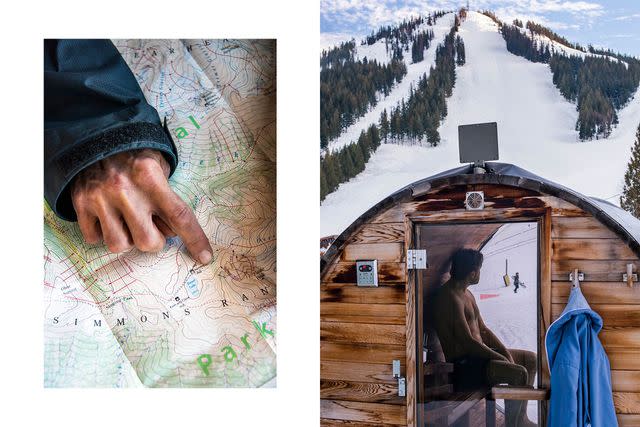
Kari Medig
From left: Selda examines a map of the Spearhead Traverse, in the Whistler backcountry; a slopeside sauna at the Josie Hotel, part of Red Mountain Resort, in Rossland.Whistler Village was buzzing with brightly dressed skiers and snowboarders lining up for the gondola. Medig and I instead wandered into the offices of Extremely Canadian, a guide service that hires former Olympians and ski-movie stars to give “extreme skiing” lessons and lead backcountry tours. Medig and I have our own backcountry equipment — lightweight Black Diamond skis with special “tech” bindings that let you walk as well as ski; ski boots that flex for a more natural stride; removable synthetic “skins” that stick to ski bases and grip the snow for uphill travel; a beacon that allows rescuers to quickly find an avalanche victim; and a shovel and a probe to expedite that rescue. All of it can easily cost thousands of dollars to buy, so 90 percent of the people who come through these doors — from Amazon executives to college students whose parents just want them to be safe — coordinate almost all of it through Extremely Canadian. It’s the perfect place for first-timers.
The first people to ski the Spearhead, in May 1964, needed nine days and had to shoulder heavy packs full of tents and other supplies. Today, thanks to huts being built along the route, people will be able to do it more comfortably over the course of just a few days.
“The thing that makes Whistler so great is the size of the accessible terrain,” co-owner Peter Smart told me. “You can ride a lift up to get to the good stuff, have an awesome day in the wilderness, and then be back in town for dinner.”
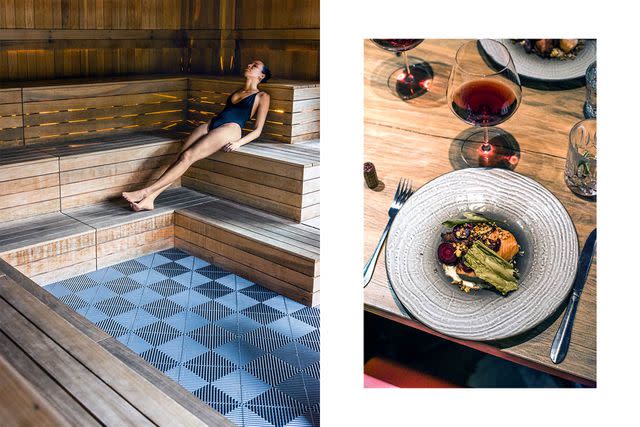
Kari Medig
From left: Relaxing at Scandinave Spa Whistler; smoked sable with Formanova beets and fried bull kelp at Alta Bistro.Smart introduced us to Selda, who was 43, trim, and wearing a yellow ski ensemble. Selda grew up on Long Island and found his way to a career in the Canadian mountains after the loss of a close friend in high school inspired him to go on outdoor adventures.
Resort skiing at Whistler-Blackcomb happens on those two namesake mountains, and the easiest way to get between them is to ride the thrilling 2.7-mile-long Peak 2 Peak gondola that drifts 1,361 feet over the valley floor. Selda was going to take us on the harder option, the Spearhead Traverse, a wild, 21-mile-long route that runs in a horseshoe shape between the peaks. The first people to ski the Spearhead, in May 1964, needed nine days and had to shoulder heavy packs full of tents and other supplies.
Today, thanks to huts being built along the route, people will be able to do it more comfortably over the course of just a few days. The three shelters will eliminate the need to carry camping and cooking gear, but they’re hardly going to be luxurious. They will, however, be architectural wonders of warmth and efficiency. Our plan was to do the last third of the Spearhead Traverse via an out-and-back adventure, spending one night at the first to be completed, called the Kees & Claire Memorial Hut, after Kees Brenninkmeyer and Claire Dixon, two beloved Alpine Club of Canada volunteers who died in an accident in 2007.
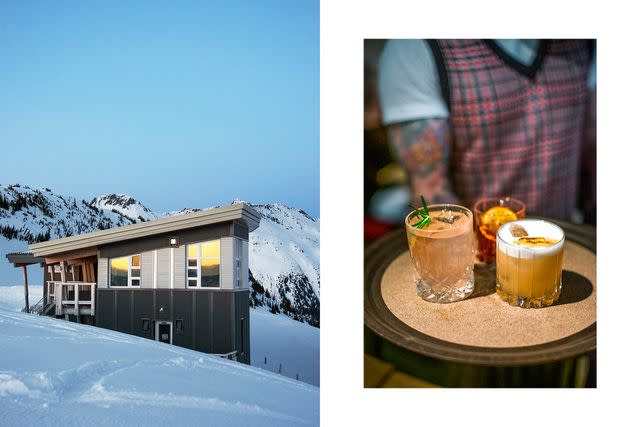
Kari Medig
From left: Sunset at the Kees & Claire Memorial Hut; cocktails at Alta Bistro, in Whistler.My pack felt blissfully light (just a sleeping bag, sleeping pad, some food, and water) as Selda, Medig, and I zoomed down Burnt Stew. We left the run, slapped on skins, and slipped past a gate that marked the boundary between the resort and the backcountry. “There’s something really great about being out here, away from loud things,” Selda said as we glided along.
Related: The 10 Best Ski Backpacks of 2022
We spent the morning navigating the Musical Bumps, a series of hills. When we reached each summit, we would remove our skins and lock down our bindings for short shots through untracked snow. At the bottom, we switched to climbing mode again. Along the way we fell into a rhythm — and I began to notice something remarkable.
On each upward climb, Selda plotted a masterful course that kept us ascending, but never so steeply that my heart rate redlined. He found wind-scoured pockets that offered less resistance, and he explored the shadows to study the feel of the crystals. To watch how he did this was to contemplate the minutiae of all the little pieces that combine to make a mountain. When approached with so much mindfulness, the uphills became as pleasing as the downs, our tracks a brush drawn across the impasto of winter.
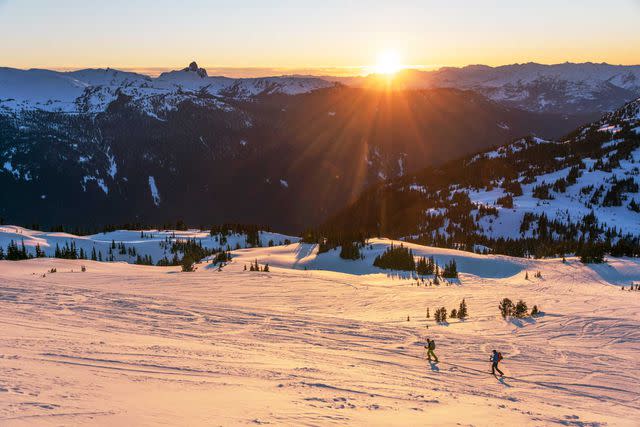
Kari Medig
Selda and the author returning home at sunset, with the Black Tusk stratovolcano poking up from the horizon.
By noon we came around a bend to find a semicircular pod of wood, steel, and glass gleaming in the sun: Kees & Claire. A group of skiers was just leaving.
“Whoa!” I exclaimed.
“The Taj Ma-hut,” one of the skiers joked.
“Yeah, not your normal hut,” Selda added.
Inside we donned slippers and found an alpine IKEA. Pale-wood-paneled walls frame rooms with bunk beds (but no bedding or mattresses). There’s a gear room with clever pulleys and racks for drying skins and boots, and a kitchen with four cooking stations, cabinets full of dinnerware, and tables lined with blue-green chairs. In the corner stands a gas fireplace and a reading nook. The hut has no plumbing (though there are foot-powered toilets). For water, guests must melt snow hauled in from outside. But the luxury is all in the location: beyond a wall of southeast-facing glass, we could see the 7,960-foot Whirlwind Peak.
We scarfed down a quick lunch of aged cheddar and saucisson fermier on rosemary crackers. Then we grabbed only our rescue gear for an afternoon of skiing. Selda took us over to Adit Lakes, where the cold had sucked the moisture from the snow to produce a fast, silky-smooth descent, and to a spot called the Corral, where we found fantastic, feathery snow that was deep enough to float in but not so deep we wallowed.
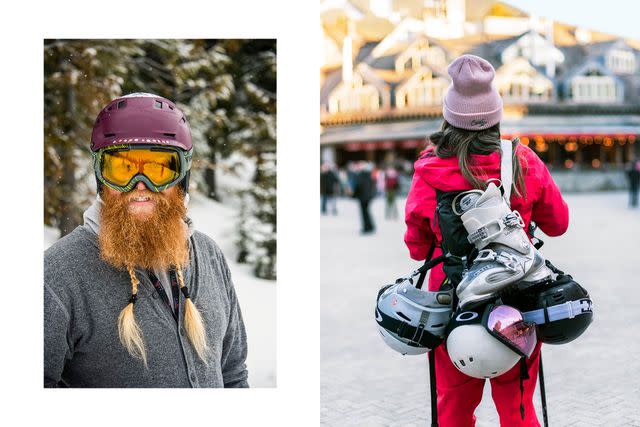
Kari Medig
From left: Instructor Ryan Colpitts; toting ski gear through Whistler Village.I slept the hell out of my sleeping bag that night. In the morning Selda said he wanted to take us up Whirlwind Peak for a proper adventure. “It’s nice to stand on a mountain,” he said. We were out the door before 9 a.m., fueled on oats and coffee.
We pushed steadily up a broad face, the snow zipping under our skins as we rode that balance between ease and exertion. By 10:30 a.m. we were standing on the long thin finger of the summit. The Spearhead’s second hut, originally planned for 2021 but since delayed, will sit to the northeast of here.
More Trip Ideas: How to Hit All of Canada's Best Ski Resorts on One Epic Roadtrip
“I love this,” Selda said, maybe to himself, maybe to no one.
From the summit, it was more than a vertical mile back down to Whistler Village, a thigh-burner that took us two hours to complete. Back in town, everything seemed loud and ridiculously convenient. I’d barely removed my skis for the walk back to the Fairmont Gold — a separate hotel inside the Fairmont Chateau Whistler — when I watched a guy at the Longhorn Saloon spray a bottle of champagne into a willing crowd. Reentry was brutal, but we had one more thing to do.
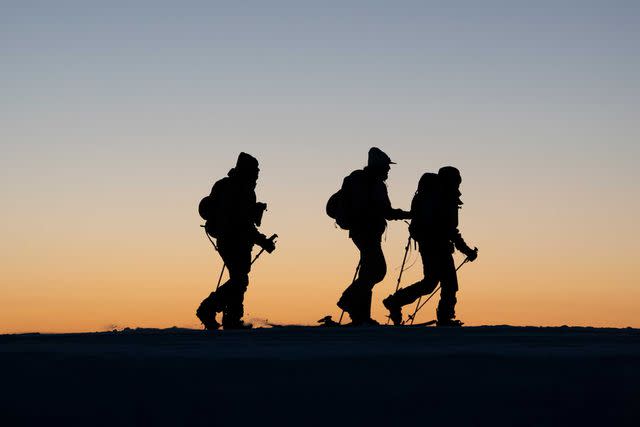
Kari Medig
Skiers returning to Kees & Claire hut at dusk after a day of backcountry skiing.The next day Medig and I took a one-hour flight from Vancouver to Trail Regional Airport, then drove 20 minutes to Rossland, a small town about 120 miles north of Spokane, Washington. Olaus Jeldness, a Norwegian mining engineer with a push-broom mustache, first brought skiing to Rossland in 1896, and today it is home to the wonderfully retro Red Mountain Resort. We checked in to the Josie Hotel, a 106-room property where the airy suites have floor-to-ceiling windows, large living rooms, and nightstands flecked with gold (a nod to the historic mine that gave the hotel its name). I counted 23 steps from the door to the chairlift.
When approached with so much mindfulness, the uphills became as pleasing as the downs, our tracks a brush drawn across the impasto of winter.
Medig and I wanted more backcountry skiing, but not more of the work, so we found ourselves trundling along through the forests near Rossland in the back of a snowcat run by Big Red Cats. We joined a handful of other skiers, all of them Americans — contractors, a weatherman, a doctor from Flint, Michigan — who’d signed up for a day of deep-powder skiing. Unlike heliskiing, where flights can be intensely noisy and stomach-churning, cat skiing is more relaxed. It’s a perfect stepping stone to improve your backcountry skills, and also costs a fraction of what heliskiing does.
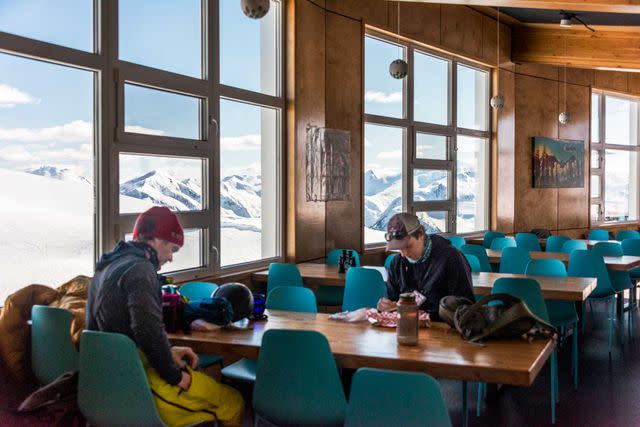
Kari Medig
Selda and the author inside the Kees & Claire hut.We spent hours dropping down steep faces through the trees and blasting along creek beds. We hooted and hollered through swatches of untracked snow. At the bottom of each run, the cat would wait and ferry us back up in a 20-minute ride, giving us time to eat sandwiches and rest. After several hours, we had logged seven runs; conditions had grown challenging as the day warmed, until the snow was as heavy and thick as mashed potatoes. I fell, hard. Snow caked my goggles and melted down my back. “Snow snake bite you?” joked Matt Lewis, our 28-year-old guide, referencing the mythical, unseen creature that skiers blame for tangling up their skis and making them fall.
“They’re everywhere today,” I said.
Matt announced that we had time for one final run, this one through trees as tight as toothpicks. Soon, Medig and I would be back at the Josie for Paper Plane cocktails and steaks with chimichurri. On our last day we’d rip around Red Mountain, a throwback to the days with no lift lines and old hermit cabins tucked into the forest. Riding the chairlifts to the top of groomed runs would feel so easy and free, after all this.
Standing there before our last cat-skiing run, I let the rest of our group go first. One by one they dropped in, until only Lewis and I remained. I took a moment to let this simplified world of ups and downs, steeps and flats, sink in. Then I cast off into the woods, my skis finding their way between the shadows and the light.
Chasing Powder in British Columbia
Whistler
Fairmont Chateau Whistler: It doesn’t get more luxe than this ski-in, ski-out hotel at the base of Blackcomb Mountain. Guests who book into Fairmont Gold have a private floor with concierge service, separate check-in area, and dedicated lounge.
Alta Bistro: The go-to spot for inventive après snacks like elk tartare and Dungeness crab and tuna éclairs.
Extremely Canadian: Whether you’re testing your ski legs at a day clinic or going big on the Spearhead Traverse, you’ll find the guides at this longtime outfitter to be the best in town.
Scandinave Spa Whistler: Unwind after a day on the slopes with a visit to the outdoor hot baths, saunas, and cold plunges, all set within a spruce and cedar forest.
Rossland
The Josie: This slopeside Red Mountain property draws a lively crowd — the hotel’s Velvet Restaurant & Lounge has superb cocktails and hearty mains, like Cornish hen with Saskatchewan chanterelles, sweet corn, and Yukon Gold gnocchi.
Gabriella’s Restaurant: Indulge in the “Trip Around Italy” menu, with six courses, each dedicated to a different region of the country, including lesser-known Lombardy and Calabria.
Rossland Beer Co.: Have a milk stout at this low-key brewery in the heart of town.
Big Red Cats: This tour operator runs cat-skiing day trips across 20,000 acres of prime terrain.
A version of this story first appeared in the December 2022/ January 2023 issue of Travel + Leisure under the headline "Into Thin Air"
For more Travel & Leisure news, make sure to sign up for our newsletter!
Read the original article on Travel & Leisure.

